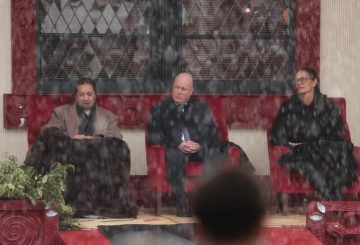Tinawag ang mga serbisyong pang-emergency sa Pringle House sa Wellington noong Martes ng umaga matapos masugatan ang isang squatter na bumagsak sa tatlong palapag sa pamamagitan ng nabulog na hagdanan. Ang lalaki ay nasa kritikal na kondisyon ngayon sa Wellington Hospital. Itinatampok ng insidente ang isyu ng kawalan ng tirahan sa lungsod, kasama ang City Missioner na si Murray Edridge, na nagsasabi na marahil hindi ito isang natatanging sitwasyon.
Sinabi ni Edridge na habang hindi isasaalang-alang ng karamihan sa mga tao ang pamumuhay sa isang mapanganib, nalulong na gusali, para sa mga nakakaranas ng kawalan ng tirahan, maaaring ito ang pinakamahusay na pagpipilian na magagamit. Idinagdag niya na sa mas malamig at mas basa na panahon, mas maraming tao ang naghahanap ng kanlungan sa mga hindi ligtas na gusali. Kinilala niya ang presyon na inilalagay nito sa mga may-ari ng gusali at sa konseho upang maiwasan ang pag-access sa mga mapanganib na puwang, ngunit binigyang diin na hindi nito tinutugunan ang isyu ng kawalan ng tirahan.
Tinatayang ni Edridge na mayroong pagitan ng 150 at 200 katao na nakatira sa mga lansangan sa Wellington, na may marami pang “hindi nakikita sa sistema”, na nakatira sa mga karavan, shed, kotse, o masikip na bahay. Nanawagan niya ang komunidad na kumuha ng responsibilidad para sa isyu, na binabanggit ang kakulangan ng kalidad, abot-kayang mga tahanan sa lungsod.
Ang Mayor ng Wellington na si Tory Whanau ay nakikipagtulungan sa Ministro ng Gusali at Konstruksiyon na si Chris Penk upang tuklasin kung dapat magkaroon ng mas maraming kapangyarihan ang mga konseho upang harapin ang Naayos na ang mga plano upang hikayatin ang pag-unlad ng mga bakanteng gusali, kabilang ang isang panukala na singilin ng mas mataas na rate sa mga may-ari ng bakanteng lupa at mga nabawalang gusali. Ang panukala ay maaaring makaapekto sa halos 60 mga pag-aari. Binanggit din ni Whanau ang pangangailangan na suriin ang mga regulasyon sa gusali na may kaugnayan sa lindol, dahil marami sa mga bakanteng gusali ng lungsod ang naapektuhan ng mga patakarang ito.




























































